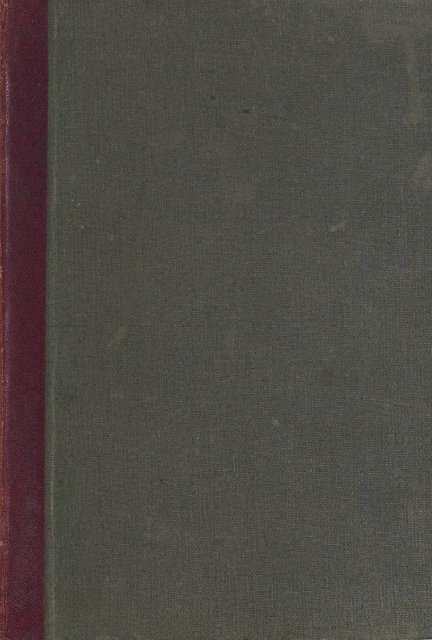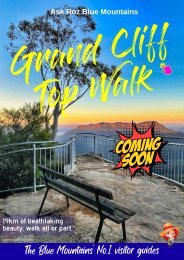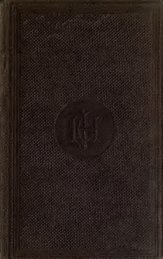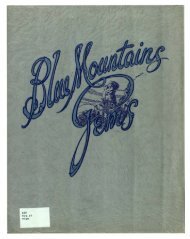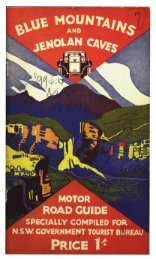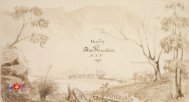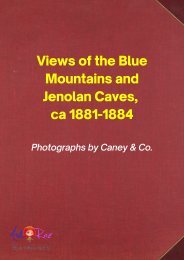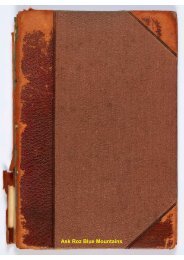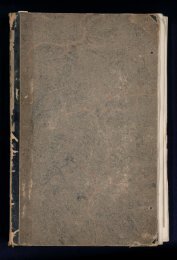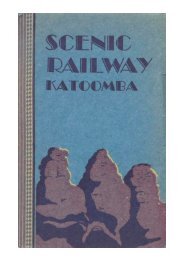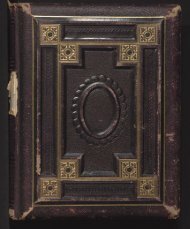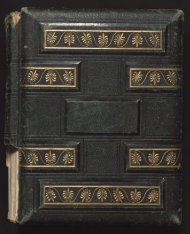A History of the Birds of NSW by John William Lewin
A History of the Birds of NSW by John William Lewin COLLECTED, ENGRAVED, AND FAITHFULLY PAINTED AFTER NATURE
A History of the Birds of NSW by John William Lewin
COLLECTED, ENGRAVED, AND FAITHFULLY PAINTED AFTER NATURE
You also want an ePaper? Increase the reach of your titles
YUMPU automatically turns print PDFs into web optimized ePapers that Google loves.
4<br />
‘ - WAR1964 s'’
i MAR 1964
NATURAL HISTORY<br />
OF THE<br />
BIRDS OF NEW SOUTH WALES<br />
COLLECTED, ENGRAVED, AND FAITHFULLY PAINTED AFTER NATURE,<br />
JOHN WILLIAM LEWIN, A.L.S.<br />
LATE OF PARAMATTA, NEW SOUTH WALES.<br />
NEW AND IMPROVED EDITION,<br />
TO WHICH IS ADDED<br />
A LIST OF THE SYNONYMES OF EACH SPECIES,<br />
INCORPORATING THE LABOUR3 OP<br />
T. GOULD, ESQ., N. A. VIGORS, ESQ., T. HORSFIELD, M.D., AND W. SWAINSON, ESQ.<br />
LONDON:<br />
HENRY G. BOHN, 4, YORK STREET, COVENT GARDEN.<br />
MDCCCXXXVIII.
INDEX OE SYNONYMES,<br />
In re-issuing <strong>the</strong> remaining copies <strong>of</strong> <strong>Lewin</strong>’s valuable work on <strong>the</strong> “ <strong>Birds</strong> <strong>of</strong> New Holland,” <strong>the</strong><br />
Publisher has endeavoured to render it as complete as possible, <strong>by</strong> having <strong>the</strong> whole <strong>of</strong> <strong>the</strong> Plates care¬<br />
fully and accurately coloured, from specimens obligingly lent him for that purpose <strong>by</strong> Mr. Gould ; and<br />
<strong>by</strong> adding a correct List <strong>of</strong> <strong>the</strong> Synonymes <strong>of</strong> each species, in which he has availed himself <strong>of</strong> <strong>the</strong> labours<br />
<strong>of</strong> those eminent Ornithologists, Messrs. Vigors, Horsfield, Swainson, Gould, Jardine and Sel<strong>by</strong>, and<br />
especially <strong>of</strong> T. C. Eyton, Esq. who kindly superintended <strong>the</strong> whole. It is hoped that <strong>by</strong> this<br />
means <strong>the</strong> work will he rendered more valuable both to <strong>the</strong> scientific and <strong>the</strong> general reader.<br />
Plate 1.—Three-toed Kingsfisher.<br />
Ceyx azurea, Jard. & Selb. Ill. Orn. vol. i. pi. 55. fig. 1.—<br />
Vig. & Horsf. in Linn.Trans, vol. xv. p. 208.<br />
Alcedo azurea, Lath. Ind. Orn. Supp. p. 32.—Swains.<br />
Zool. Ill. 1st ser. pi. 26.<br />
Azure Kingsfisher, Lath. Gen. Syn. Supp. vol. ii. add.<br />
p. 372. and Gen. Hist. vol. iv. p. 61.<br />
Tridigitated Kingsfisher, Shaw, Gen. Zool. vol.viii. p. 105.<br />
Alcedo tribrachys, Nat. Misc. pi. 681.—Temm. Mann. 2d.<br />
Edit. p. lxxxviii.<br />
Plate 2.—Mountain Eee-eater.<br />
Merops melanurus, Yig. & Horsf. in Linn. Trans, vol. xv.<br />
p. 208.<br />
Plate 3.—Waty-faced Honeysucker.<br />
Anthoclisera Phrygia, Yig. & Horsf. in Linn. Trans, vol. xv.<br />
p. 322.<br />
Merops Phrygius, Lath. Ind. Orn. Supp. p. 34.<br />
Black and Yellow Honey-eater, Lath. Gen. Hist. vol. iv.<br />
p. 165.<br />
Plate 4.—Blue-faced Honeysucker.<br />
Tropidorhynchus cyanotis, Vig. & Horsf. in Linn. Trans,<br />
vol. xv. p. 225.<br />
Gracula cyanotis, Lath. Ind. Orn. Supp. p. 29.—Shaw,<br />
Gen. Zool. vol. iv. p. 474.<br />
Graculine Honey-eater, Lath. Gen. Hist. vol. iv. p. 166.<br />
Blue-eared Grakle, Lath. Gen. Syn. Supp. vol. ii. p. 130.<br />
Plate 5.—Yellow-eared Honeysucker.<br />
Ptilotis chrysotis, Gould. Syn. <strong>Birds</strong> <strong>of</strong> Australia, part iv.<br />
Spot-eared creeper, Shaw, Gen. Zool. vol. viii. p. 244.<br />
Meliphaga chrysotis, Vig. & Horsf. in Linn. Trans, vol.xv.<br />
p. 314.—Gould, Syn. <strong>Birds</strong> <strong>of</strong> Australia, part i.<br />
Certhia chrysotis, Lath. Ind. Orn. Supp. p. 38.<br />
Yellow-eared Creeper, Lath. Gen. Syn. Supp. vol. ii. p. 109.<br />
Yellow-eared Honey-eater, Lath. Gen. Hist. vol. iv. p. 195.<br />
Ptilotis <strong>Lewin</strong>ii, Swains. Class, <strong>of</strong> <strong>Birds</strong>, vol. ii. p. 326.<br />
Plate 6.—King Honeysucker.<br />
Sericulus chrysocephalus, Swains, in Zool. Journ. vol. i.<br />
p. 478.—Vig. & Horsf. in Linn. Trans, vol. xv.<br />
p. 326.—Jard. & Selb. Ill. Orn. vol. i. pis. 18,<br />
19, 20.<br />
Golden-crowned Honey-eater, Lath. Gen. Hist. vol. iv.<br />
p. 184.<br />
Loriot Prince Regent, Temm. PI. Col. 320.—Quoy et<br />
Gaim. Preycinet’s Voy. Autour du Monde, pi. 22.<br />
Plate 7.—Crimson-throated Flycatcher.<br />
Dicteum gularis.<br />
Dicaeum sanguinea, Swains. Class, <strong>of</strong> <strong>Birds</strong>, vol. ii.<br />
Crimson-throated Manakin, Lath. Gen. Syn. Suppl. vol. ii.<br />
p. 254. and Gen. Hist. vol. vii. p. 240.<br />
Pipra gularis, Lath. Ind. Orn. Supp. p. 57.—Steph. Cont.<br />
Shaw, Gen. Zool. vol. x. p. 17.<br />
Pardalotus gularis, ibid. vol. xiii. p. 252.<br />
Plate 8.—Orange-breasted Thrush.<br />
Pachycephala pectoralis, Vig. & Horsf. in Linn. Trans.<br />
vol. xv. p. 239.—Gould, Syn. <strong>Birds</strong> <strong>of</strong> Australia,<br />
part iii.—<strong>Birds</strong> <strong>of</strong> Australia, part ii.<br />
Muscicapa pectoralis, Lath. Ind. Orn. Supp. p. Ii.<br />
Black-breasted Flycatcher, Lath. Gen. Syn. Supp. vol. it.<br />
p. 222.<br />
Guttural Thrush, var. A. Lath. Gen. Hist. vol. v. p. 136.<br />
Pachycephala striata, Vig. & Horsf. in Linn. Trans, vol. xv.<br />
p. 240. fem. or young male ?<br />
Lanius macularius, Quoy et Gaim. Voy. de 1’Astrolabe,<br />
p. 257. pi. 31. fig. 1. young male ?<br />
Plate 9_Crested Thrush.<br />
Oreo'ica gutturalis, Gould, Syn. <strong>Birds</strong> <strong>of</strong> Australia, part iv.<br />
Falcunculus gutturalis, Vig & Horsf. in Linn. Trans,<br />
vol. xv. p. 212.
t<br />
-
Plate 10.—Black-crowned Thrush.<br />
Pachycephala gutturalis, Vig. & Horsf. in Linn. Trans.<br />
vol. xv. p. 239.—Gould, Syn. <strong>Birds</strong> <strong>of</strong> Australia,<br />
part iii.<br />
Turdus gutturalis, Lath. Ind. Orn. Supp. p. xli.<br />
Guttural Thrush, Lath. Gen. Syn. Supp. vol. ii. p. 182. and<br />
Gen. Hist. vol. v. p. 136.—Shaw, Gen. Zool.<br />
vol. x. p. 256.<br />
Plate 11.—Spotted Grosbeak.<br />
Amadina Latliami, Gould, Syn. <strong>Birds</strong> <strong>of</strong> Australia, part ii.<br />
Fringilla Lathami, Vig. & Horsf. in Linn. Trans, vol. xv.<br />
p. 256.<br />
Spotted-sided Grosbeak, Lath. Gen. Hist. vol. v. p.248.<br />
pi. 89.—Shaw, Gen. Zool. vol. ix. p. 493.<br />
Plate 12.—Common Grosbeak.<br />
Fringilla temporalis, Lath. Ind. Orn. Supp. p. xlviii.—Vig.<br />
& Horsf. in Linn. Trans, vol. xv. p. 258.—Jard.<br />
& Selb. Ill. Om. vol. i. pi. 12. fig. 1. male,<br />
2. female.<br />
Temporal Finch, Lath. Gen. Syn. Supp. vol. ii. p. 211. and<br />
Gen. Hist, vol, vi. p. 115.—Shaw, Gen. Zool.<br />
vol. ix. p. 533.<br />
Plate 18.—Reed Warbler.<br />
Calamoherpe Australis, Gould.<br />
Plate 19.—Scarlet Creeper.<br />
Myzomela cardinalis, Vig. & Horsf. in Linn. Trans, vol.<br />
xv. p. 316.<br />
Certhia cardinalis, Gmel. Syst. vol. i. p. 472.—Lath. Ind.<br />
Orn. vol. i. p. 299.<br />
Le Soul Manga rouge et gris, Vieill. ois. dor. tom.ii. p.58.<br />
pi. 36.<br />
Cardinal Honeysucker, Lath. Gen. Hist. vol. iv. p. 199.<br />
pi. 71. fig. 2.<br />
Plate 20.—White-eared Honeysucker.<br />
Ptilotis leucotis, Swains. Class, <strong>of</strong> <strong>Birds</strong>, vol. ii. p. 326.<br />
Turdus leucotis, Lath. Ind. Orn. p. xliv.<br />
White-eared Honeyeater, Lath. Gen. Hist. vol. iv. p. 186.<br />
White-eared Thrush, Lath. Gen. Syn. Supp. vol.ii. p. 373.<br />
Meliphaga leucotis, Vig. & Horsf. in Linn. Trans, vol. xv.<br />
p. 314.—Jard. & Selb. Ill. Orn. vol. i. pi. 35.<br />
fig. 2.—Temm. Man. part i. p. Ixxxvii.—Temm. PI.<br />
Col. 435.—Gould, Syn. <strong>Birds</strong> <strong>of</strong> Australia, part i.<br />
Plate 21.—Crested Flycatcher.<br />
Myi'agra plumbea, Vig. & Horsf. in Linn. Trans, vol. xv.<br />
p. 254.<br />
Plate 13.—Orange-rumped Flycatcher.<br />
Rhipidura rufifrons, Vig. & Horsf. in Linn. Trans, vol. xv.<br />
p. 248.<br />
Muscicapa rufifrons, Lath. Ind. Om. Supp. p. 1.<br />
Rufous-fronted Flycatcher, Lath. Gen. Syn. Supp. vol. ii.<br />
p. 220. and Gen. Hist. vol. vi. p. 213.—Shaw,<br />
Gen. Zool. vol. x. p. 373.<br />
Plate 14.—Scarlet-backed Warbler.<br />
Malurus Brownii, Vig. & Horsf. in Linn. Trans, vol. xv.<br />
p. 223.—Jard. & Selb. Ill. Orn. vol. ii. pi. 72.<br />
fig. 1.<br />
Plate 15.—Variegated Warbler.<br />
Malurus Lamberti, Vig. & Horsf. in Linn. Trans, vol. xv.<br />
p. 221.—Jard. & Selb. Ill. Orn. vol. ii. pi. 72.<br />
fig. 2.—Gould, Syn. <strong>Birds</strong> <strong>of</strong> Australia, part i.<br />
Plate 16.—Rock Warbler.<br />
Origma solitaria, Gould, Syn. <strong>Birds</strong> <strong>of</strong> Australia, part iv.<br />
Saxicola solitaria, Vig. & Horsf. in Linn. Trans, vol. xv.<br />
p. 236.<br />
Solitary Flycatcher, Lath. Gen. Hist. vol. vi. p. 220.<br />
Plate 17.—Red-breasted Warbler.<br />
Petroica multicolor, Swains. Zool. Ill. 2nd ser. pi. 36.—<br />
Gould, Syn. <strong>Birds</strong> <strong>of</strong> Australia, part i.<br />
Muscicapa multicolor, Gmel. Syst. vol. i. p. 944.—Vig. &<br />
Horsf. in Linn. Trans, vol. xv. p. 243.<br />
Muscicapa erythrogastra, Lath. Ind. Orn. p. 479.—Gmel.<br />
Syst. vol. i. p. 944.<br />
Red-bellied Flycatcher, Lath. Gen. Syn. vol. iii. p. 343.<br />
pi. 50.—Id. Supp. vol. ii. p. 216.—Nat. Misc.<br />
pi. 147.—Shaw, Gen. Zool. vol. x. p. 400. pi. 32.—<br />
Lath. Gen. Hist. vol. vi. p. 209. pi. 100.<br />
Plate 22.—White-breasted Honeysucker.<br />
Gliciphila fulvifrons, Swains. Class, <strong>of</strong> <strong>Birds</strong>, vol. ii.<br />
Meliphaga fulvifrons, Vig. & Horsf. in Linn. Trans.vol. xv.<br />
p. 317.<br />
Plate 23.—Yellow-breasted Thrush.<br />
Eopsaltria Australis, Gould, Syn. <strong>Birds</strong> <strong>of</strong> Australia, part iv. ?<br />
Pachycephala Australis, Vig. & Horsf. in Linn. Trans,<br />
vol. xv. p. 242.<br />
Sou<strong>the</strong>rn Motacilla, White’s Voy. pi. in p. 239.<br />
Sou<strong>the</strong>rn Flycatcher, Lath. Gen. Hist. vol. vi. p. 216.<br />
Eopsaltria flavicollis, Swains. Class, <strong>of</strong> <strong>Birds</strong>, vol. ii.<br />
p. 250<br />
Plate 24.—Black-crowned Honeysucker.<br />
Hasmatops lunulatus, Gould, Syn. <strong>Birds</strong> <strong>of</strong> Australia, part i.<br />
Certhia lunulata, Shaw, Zool. vol. viii. p. 224.<br />
Le Fuscalbin, Vieill. Ois. dor. tom. ii. p. 95. pi. 61.<br />
Red-eyed Honeyeater, Lath. Gen. Hist. vol. iv. p. 203.<br />
Meliphaga lunulata, Vig. & Horsf. in Linn. Trans, vol. xv.<br />
p. 315.—Jard. & Selb. Ill. Orn. vol. iii. pi. 134.<br />
fig. 2.<br />
Meliphaga atrieapilla, Temm. PL Col. 335. fig. 1.<br />
Meliphaga torquata, Swains. Zool. Ill. 1st ser. pi. 116.<br />
Gymophrys torquatus, Swains. Class <strong>of</strong> <strong>Birds</strong>, vol. ii.<br />
p. 327.<br />
Plate 25.—Common Creeper.<br />
Climacteris scandens, Temm. PI. Col. 281. fig. 2.—Vig. &<br />
Horsf. in Linn. Trans, vol. xv. p. 296.<br />
Plate 26.—Crested Shrike.<br />
Faleunculus frontatus, Stepli. Cont. <strong>of</strong> Shaw, Gen. Zool.<br />
vol. xiii. p. 149. pi. 50.—Vig. & Horsf. in Linn.<br />
Trans, vol. xv. p. 212.<br />
Lanius frontatus, Lath. Ind. Orn. and Supp.—Shaw, Gen.<br />
Zool. vol. vii. p. 312.—Temm. PI. Col. 77.<br />
Frontal Shrike, Lath. Gen. Hist. vol. ii. p. 72. pi. 20.
t .<br />
/<br />
/<br />
/<br />
■
*
THE<br />
mums:
2<br />
MOUNTAIN BEE-EATER.<br />
(PL II.)<br />
BEAK curled, flatted, and heel-shaped.<br />
TONGUE divided at <strong>the</strong> point.<br />
TOES four, three before and one behind, united toge<strong>the</strong>r as in <strong>the</strong> Kingfisher, or Alccedce Genus.<br />
LENGTH<br />
Eight inches and a half; bill one inch and an eighth and black ; eye orange ;<br />
lashes black ; forehead pea-green ; crown chesnut; through <strong>the</strong> eye and cheek black,<br />
edged with light blue; chin yellow, deepening to a chesnut as it passes to <strong>the</strong> throat,<br />
which is black ; neck, back, and shoulders, bright changeable pea-green ; rump and<br />
tail-coverts light blue; primaries green tipt with black; secondaries chesnut tipt<br />
with <strong>the</strong> same; greater wing-coverts blue ; breast and belly pea-green ; vent and under<br />
tail-coverts blue; tail black and forked, two outer fea<strong>the</strong>rs edged with green ; quills<br />
<strong>of</strong> two middle tail-fea<strong>the</strong>rs, extend an inch below <strong>the</strong> o<strong>the</strong>r ; legs and claws brown.<br />
INHABITS<br />
Mountains; frequents <strong>the</strong> Hawkesbury under <strong>the</strong> hills, where a few breed every<br />
summer. This species appears <strong>the</strong> latter end <strong>of</strong> September, and migrates in April.
■<br />
- ■'<br />
.<br />
'<br />
■<br />
♦ :
'<br />
\<br />
■<br />
\ • . •<br />
. V<br />
X\ \
J*ML<br />
i<br />
t<br />
S - Wc*.£+
FUK<br />
/7t GC0.. ci/jr^ /%. JPaJes
3<br />
WATY-FACE HONEY-SUCKER.<br />
(PL III.)<br />
LENGTH<br />
Eight inches and a quarter; hill half an inch and black; eyes brown; lashes<br />
grey; forehead, crown, chin, throat, and neck, deep black; from <strong>the</strong> base <strong>of</strong> <strong>the</strong> bill<br />
round <strong>the</strong> eye and part <strong>of</strong> <strong>the</strong> cheek a warty pale yellow patch, covered with hard<br />
oblong excrescences; back, rump, tail-coverts, breast and belly, vent and thighs,<br />
black, with angular markings <strong>of</strong> pale yellow; shoulders black; lesser wing-coverts <strong>the</strong><br />
same, edged with pale yellow; tail cuneiform, <strong>the</strong> second middle fea<strong>the</strong>rs black, in <strong>the</strong><br />
o<strong>the</strong>r fea<strong>the</strong>rs <strong>the</strong> black only reaches half way, <strong>the</strong> half is bright yellow ; legs and<br />
claws brown.<br />
INHABITS<br />
These beautiful birds were seen near Paramatta, in great numbers, constantly flying<br />
from tree to tree, (particularly <strong>the</strong> blue gum,) feeding among <strong>the</strong>blossoms, extracting<br />
<strong>the</strong> honey with <strong>the</strong>ir long fibrous tongues from every flower as <strong>the</strong>y passed. Many <strong>of</strong><br />
<strong>the</strong>m remained that summer and <strong>the</strong>n disappeared.
4<br />
n<br />
BLUE-FACE HONEY-SUCKER.<br />
(PI. IV.)<br />
LENGTH<br />
t<br />
Thirteen inches; bill one inch, <strong>the</strong> lower half grey, <strong>the</strong> o<strong>the</strong>r black ; eye yellow;<br />
lashes grey; round <strong>the</strong> eye a naked blue skin ; forehead and crown black ; hind-head<br />
white; cheek and back <strong>of</strong> <strong>the</strong> neck grey-black ; chin and throat grey; from <strong>the</strong><br />
base <strong>of</strong> <strong>the</strong> bill on each side white, which passes in a line to <strong>the</strong> breast; breast, belly,<br />
and vent, white; back and rump bright olive; primaries brown, edged with grey;<br />
tail olive, tipt with white, and cuneiform ; legs and claws dark grey.<br />
Forests; frequents blue gum trees.<br />
INHABITS<br />
REMARKS.<br />
This species are fond <strong>of</strong> pecking traverse holes in <strong>the</strong> bark, between which and <strong>the</strong><br />
wood <strong>the</strong>y insert <strong>the</strong>ir long tongues in search <strong>of</strong> small insects, which <strong>the</strong>y draw to <strong>the</strong>m<br />
with great dexterity. It is a noisy chattering bird.
' *<br />
r:<br />
N.<br />
■<br />
f<br />
\<br />
I<br />
/<br />
*
?<br />
PLJV.
l<br />
f
J'L.V.<br />
■ -—c/c.w
5<br />
YELLOW-EAR HONEY-SUCKER.<br />
(PI. V.)<br />
BEAK arched, stout, and almost tliree-sided.<br />
NOSTRILS long, and covered with a membrane.<br />
TONGUE long, and split into a number <strong>of</strong> hairy fibres at <strong>the</strong> end, brush-like.<br />
TOES formed for climbing.<br />
The birds <strong>of</strong> this genus feed upon <strong>the</strong> honey combined with <strong>the</strong> infinitely small insects lodged<br />
in most <strong>of</strong> <strong>the</strong> flowers <strong>of</strong> New South Wales, which <strong>the</strong>y extract in a dexterous manner with <strong>the</strong>ir<br />
tongues, peculiarly formed for that purpose.<br />
LENGTH<br />
Eight inches; bill six-eighths and black ; <strong>the</strong> corner <strong>of</strong> <strong>the</strong> mouth a pale yellow;<br />
through <strong>the</strong> eye a streak <strong>of</strong> black ; eye grey ; lashes brown ; cheek grey : behind <strong>the</strong><br />
ear a pale yellow patch ; chin, throat, breast, belly, vent, greyish olive; forehead<br />
dark grey; crown, neck, back, shoulders, and rump, dark greyish olive; primaries<br />
and secondaries dark grey, edged with bright olive; tail dark grey, edged with olive,<br />
and a little forked ; legs and claws brown.<br />
FEMALE<br />
Nearly <strong>the</strong> same, but <strong>of</strong> less bright plumage.<br />
INHABITS<br />
The neighbourhood <strong>of</strong> Paramatta and <strong>the</strong> Hawkesbury, frequenting thick bushy<br />
woods.<br />
REMARKS.<br />
In <strong>the</strong> winter season <strong>the</strong>se birds have been seen feeding on <strong>the</strong> sweet berry <strong>of</strong> <strong>the</strong><br />
white cedar in great numbers. They have a shrill and very peculiar cry, which is heard<br />
at a great distance.
6<br />
KING HONEY-SUCKER.<br />
(PI. VI.)<br />
LENGTH<br />
Nine inches and a half; bill one inch in length, and <strong>of</strong> a bright yellow-orange;<br />
eye yellow ; forehead, crown, and back part <strong>of</strong> <strong>the</strong> neck, bright goklen-yellow verging<br />
to orange ; <strong>the</strong> fea<strong>the</strong>rs short appearing like velvet; from <strong>the</strong> base <strong>of</strong> <strong>the</strong> bill to <strong>the</strong><br />
eye black; above <strong>the</strong> eye <strong>the</strong> same ; chin, cheek, throat, black ; breast, belly, and vent<br />
<strong>the</strong> same; back and shoulders deep shining blue-black ; bastard-wing black ; primaries<br />
<strong>the</strong> same; secondaries bright golden-yellow, partly tipt with black; tail black and a<br />
little forked ; legs and claws black.<br />
INHABITS<br />
The banks <strong>of</strong> Patterson’s river; frequents thick brushy woods.<br />
REMARKS.<br />
This beautiful species was shot about 30 miles from <strong>the</strong> settlement <strong>of</strong> Newcastle.
♦
f<br />
\<br />
><br />
-<br />
'■ A<br />
’ ♦
'r.. s- '<br />
A ■ ■<br />
• ■ •<br />
r<br />
- ;
i<br />
\
7<br />
CRIMSON-THROAT FLY-CATCHER,<br />
(PL VII.)<br />
LENGTH<br />
Three inches and two-eighths; bill two-eighths, <strong>the</strong> upper mandible black, <strong>the</strong><br />
lower one 'paler ; eye dark brown; lashes black ; forehead, crown, cheek, back,<br />
shoulders, and rump, deep shining blue ; primaries <strong>the</strong> same, lightly edged with pale<br />
brown ; secondaries dark brown, edged until dull white; wing-coverts <strong>the</strong> same ; chin,<br />
throat, and part <strong>of</strong> breast, fine crimson ; breast black ; sides and belly white; vent<br />
and under tail-coverts pale crimson ; legs and claws brown.<br />
INHABITS<br />
Forests; frequents high trees. It is a cheerful active bird, constantly singing a<br />
short but pleasant song in passing from tree to tree.
✓<br />
8<br />
ORANGE-BREAST THRUSH.<br />
(PL VIII.)<br />
LENGTH<br />
Seven inches; bill half an inch and black ; eye brown ; lashes grey; forehead,<br />
crown, back <strong>of</strong> <strong>the</strong> neck, shoulder, back, rump, and tail-coverts, grey ; from <strong>the</strong><br />
base <strong>of</strong> <strong>the</strong> beak black; cheeks <strong>the</strong> same; chin and throat white ; fore part <strong>of</strong> <strong>the</strong><br />
neck a black crescent-like band ; breast, belly, vent, and thigh, orange ; wing-coverts<br />
black, edged with grey, and forked ; legs and claws brown.<br />
Resembling, but plumage less bright.<br />
FEMALE<br />
INHABITS<br />
Forests ; frequents high trees, perching generally on <strong>the</strong> upper branches, where it<br />
sings a loud and not unpleasant song about daybreak.
PL.lift.
J*<br />
V:<br />
'•<br />
%<br />
' - ■-!<br />
i
9<br />
CRESTED THRUSH.<br />
(PL IX.)<br />
LENGTH<br />
Seven inches and a half; bill four-eighths and a half and brown ; eye same; lashes<br />
grey, as also <strong>the</strong> forehead ; fea<strong>the</strong>rs on <strong>the</strong> crown long and black, forming a crest,<br />
erected at pleasure ; hind head grey ; cheek and back part <strong>of</strong> neck dark grey ; back,<br />
rump, -wings, tail-coverts, a grey-brown; breast light greyish brown ; sides and<br />
vent a dull oker ; belly dull white; thighs brown ; legs and claws horn colour.<br />
INHABITS<br />
Rocks ; frequents barren scrub<strong>by</strong> places. Has a jerk in its walking motion, at <strong>the</strong><br />
same time erecting its crest like <strong>the</strong> cockatoo.
10<br />
BLACK-CROWN THRUSH.<br />
(PI. .X.)<br />
BEAK smooth, and coultec shaped; <strong>the</strong> point <strong>of</strong> <strong>the</strong> upper mandible bent downwards, and<br />
marginated.<br />
NOSTRILS naked, <strong>the</strong> upper part covered ivith a slight membrane ; jaws ciliate, and having<br />
hair.<br />
TONGUE lacerated and marginated.<br />
TOES middle connected to outer as far as <strong>the</strong> first joint.<br />
LENGTH<br />
Seven inches; bill half an inch and black ; eye brown; lashes grey; forehead, crown,<br />
and cheeks, black, which passes in a crescent-like band round <strong>the</strong> lower part <strong>of</strong> <strong>the</strong><br />
throat; chin and throat white; breast, belly, and vent, bright yellow; hind head<br />
yellow; back, rump, shoulders, and part <strong>of</strong> tail, bright olive; primaries dark<br />
grey, edged with lighter; secondary and wing-covert <strong>the</strong> same, edged with bright<br />
olive; <strong>the</strong> lower part <strong>of</strong> <strong>the</strong> tail brown-black tipt with grey; thighs grey; legs and<br />
claws brown.<br />
FEMALE<br />
Nearly <strong>the</strong> same, but <strong>of</strong> a less bright plumage.<br />
INHABITS<br />
Thick forests; frequenting <strong>the</strong> l<strong>of</strong>ty iron bark trees.<br />
REMARKS.<br />
This bird has a loud shrill and pleasant note, and sings chiefly in <strong>the</strong> morning<br />
Solitary or seen in pairs. They do not migrate.
N
77 X
y<br />
.,///:/
11<br />
4<br />
SPOTTED GROSS-BEAK.<br />
(Pl. XI.)<br />
LENGTH<br />
Four inches and a half; bill three-eighths, and <strong>of</strong> a bright red ; eye <strong>the</strong> same ; lashes<br />
flesh colour ; forehead, crown, back <strong>of</strong> <strong>the</strong> neck, and part <strong>of</strong> cheeks, grey ; from<br />
base <strong>of</strong> beak to eye a black patch ; chin white ; fore part <strong>of</strong> <strong>the</strong> neck black, with a<br />
few white spots on each side above <strong>the</strong> shoulder; underwings a deep black, with<br />
oval white spots ; breast, belly, and vent, white; back and wings greyish brown ;<br />
rump and tail coverts bright crimson ; tail black and a little forked ; legs and claws<br />
dark grey.<br />
FEMALE<br />
Nearly <strong>the</strong> same, but less bright in plumage.<br />
INHABITS<br />
Forests near Paramatta ; frequenting <strong>the</strong> sides <strong>of</strong> hills and barren places.<br />
REMARKS.<br />
These birds go in small flights in winter, and visit <strong>the</strong> gardens and o<strong>the</strong>r cultivated<br />
grounds.<br />
NATIONAL MUSEUM OF VICTORIA
12<br />
COMMON GROSS-BEAK.<br />
(PI. XII.)<br />
BEAK Conical and very gross; <strong>the</strong> forehead a little bald; <strong>the</strong> lower mandible bent a little<br />
inwards<br />
NOSTRILS at <strong>the</strong> base <strong>of</strong> <strong>the</strong> beak.<br />
TONGUE as if cut <strong>of</strong>f at <strong>the</strong> end.<br />
TOES placed three before and one behind.<br />
LENGTH<br />
Four inches and a half; bill three-eighths, and scarlet, with a black stripe on upper<br />
and under mandible ; eye red ; lashes black ; from <strong>the</strong> base <strong>of</strong> <strong>the</strong> bill above <strong>the</strong> eye<br />
to <strong>the</strong> hind head a stripe <strong>of</strong> scarlet ; crown, hind head, and cheek, dark grey ; hack<br />
part <strong>of</strong> neck, shoulder, back, and wing, brownish olive ; rump and tail coverts<br />
crimson ; tail black, lightly bound with small cross bars, and cuneiform; chin,<br />
throat, breast, and side <strong>of</strong> <strong>the</strong> belly and vent, light grey; belly oker ; legs and claws<br />
pale oker.<br />
INHABITS<br />
Barren tracts near Sydney and Paramatta. They go in large flocks in autumn and<br />
in spring, separate into pairs, and build, in low bushes, an oval-shaped nest <strong>of</strong> dead<br />
glass, lined with down <strong>of</strong> sowthistle ; lay five or six eggs, <strong>of</strong> a pale flesh colour,<br />
spotted with dull red. The male has a pleasant song. Are subject to fits.
><br />
i<br />
f<br />
k r.<br />
«r
77. JW.
'<br />
t.<br />
t<br />
.•<br />
1 ..
\<br />
PI.JLTE.
-
13<br />
ORANGE-RUMP FEY-CATCHER.<br />
(Pl.XIII.)<br />
BEAK flatted at <strong>the</strong> base, almost triangular, notched at <strong>the</strong> end <strong>of</strong> <strong>the</strong> upper mandible, and<br />
beset with bristles.<br />
NOSTRILS almost round.<br />
TOES divided as far as <strong>the</strong>ir origin.<br />
LENGTH<br />
Five inches and a half; bill tliree-eigliths and black ; eye pale brown; lashes grey;<br />
round <strong>the</strong> eye white; cheek black ; chin whi te; throat black ; breast greyish-white,<br />
spotted with black; belly, vent, and under tail-coverts, light oker; forehead<br />
chesnut; crown, hind head, back, and shoulder, brown; rump, tail-coverts, and<br />
lower part <strong>of</strong> tail, orange, <strong>the</strong> o<strong>the</strong>r half black; primaries and secondaries dark<br />
brown, edged with chesnut; legs and claws yellow flesh colour.<br />
INHABITS<br />
Thick brushes ; frequents low hushes.<br />
remarks.<br />
A chattering noisy species, constantly in motion, jerking and spreading its fan-like<br />
tail as it passes from bush to bush, catching its food in its flight.
14<br />
SCARLET-BACK WARBLER.<br />
(PL XIV.)<br />
BEAK awl-shaped and strait; <strong>the</strong> mandible almost equal, and slightly notched at top.<br />
NOSTRILS small, a little depressed.<br />
TONGUE lacerated on <strong>the</strong> margin.<br />
TOES <strong>the</strong> exterior toe joined at <strong>the</strong> under part to <strong>the</strong> base <strong>of</strong> <strong>the</strong> middle one.<br />
KB._Most <strong>of</strong> <strong>the</strong> birds <strong>of</strong> this genus live upon insects, which obliges <strong>the</strong>m to migrate south¬<br />
ward in winter in Europe, and northward in New South Wales.<br />
LENGTH<br />
Four inches five-eighths ; bill quarter <strong>of</strong> an inch and black ; eye dark brown;<br />
lashes black ; forehead, ci’own, hind head, cheeks, and nape <strong>of</strong> <strong>the</strong> neck, deep<br />
shining blue-black ; chin, throat, breast, and part <strong>of</strong> <strong>the</strong> belly, black ; back a<br />
bright scarlet; shoulder black ; wings brown ; lower part <strong>of</strong> belly and thighs pale<br />
brown ; rump black ; tail <strong>the</strong> same and cuneiform ; leg flesh colour ; claws brown.<br />
FEMALE<br />
Bill reddish-brown; above <strong>the</strong> eye a streak <strong>of</strong> <strong>the</strong> same colour ; forehead, crown,<br />
neck, back, wings, and tail, brown ; chin, throat, breast, white; belly light oker.<br />
INHABITS<br />
Forests near <strong>the</strong> banks <strong>of</strong> Patterson’s River ; frequents low bushes. The male has a<br />
a pretty song very like that <strong>of</strong> <strong>the</strong> superb warbler. They go in small flocks.
\<br />
\<br />
/<br />
'<br />
.
T> \r.v
V- -<br />
; v ;v
PI. JOT
*<br />
■<br />
.
15<br />
VARIEGATED WARBLER,<br />
(PL XV.)<br />
LENGTH<br />
Five inches and a half; bill four-eighths and black; eye black ; lashes <strong>the</strong> same ;<br />
forehead light blue; crown bluisli-hrown, edged with light blue, verging to a<br />
purple as it passes round <strong>the</strong> head ; cheeks light blue, forming a beard-like<br />
appearance on each side <strong>the</strong> face; chin, throat, neck, and breast, deep shining<br />
blue-black ; above <strong>the</strong> shoulder purple-blue ; shoulder bright chesnut; back purpleblue<br />
; rump deep black ; tail-coverts light brown ; tail greenish grey and cuneiform,<br />
<strong>the</strong> outmost fea<strong>the</strong>r tipt white; wing brown; primary and secondary edged with<br />
light chesnut; greater wing-coverts <strong>the</strong> same; breast white ; belly and vent pale<br />
oker ; thighs grey ; legs and claws brown.<br />
FEMALE<br />
Bill red ; eye black ; lashes same ; from base <strong>of</strong> bill to eye red ; <strong>the</strong> whole upper<br />
part <strong>of</strong> body and wing grey-brown ; sides <strong>of</strong> head, cheeks, and neck, blue-grey ;<br />
belly and vent light oker ; thighs brown ; tail greenish grey ; legs brown.<br />
INHABITS<br />
Thick brushy woods; frequents <strong>the</strong> low bushes, creeping close to <strong>the</strong> ground in<br />
search <strong>of</strong> its food. This bird always goes in small flocks, among which it is<br />
remarkable that one male only is to be seen in full plumage, and <strong>the</strong>y arrive not at<br />
that state till <strong>the</strong> third year. The male is a cheerful active bird, always singing<br />
on little elevated bushes it meets in its way. This species does not migrate.
16<br />
ROCK WARBLER.<br />
(PL XVI.)<br />
LENGTH<br />
Five inches ; bill three-eighths and black; eye red-brown: lashes grey; forehead,<br />
crown, hind head, neck, back, shoulders, rump, and tail-coverts brownish grey ; wings<br />
brown ; chin white, with brown spots; cheek brown ; throat dull orange; breast,<br />
belly, and vent, chesnut ; tail black, a little forked ; thighs light brown ; legs and<br />
claws <strong>the</strong> same.<br />
INHABITS<br />
Rocks ; frequents caverns inaccessible to mankind, and deep rocky gullies, creeping<br />
in <strong>the</strong> cavities and chasms. This is a shy and wary bird. Its note is sharp and shrill.<br />
Does not migrate.
N<br />
S<br />
\
■<br />
-> '<br />
*<br />
l<br />
•-<br />
/«<br />
\<br />
v
17<br />
RED-BREAST WARBLER.<br />
(PI. XVII.)<br />
LENGTH<br />
Five and half inches; bill three-eighths and black; eyes black; lashes <strong>the</strong> same;<br />
Forehead white; head, neck, chin, throat, back, rump, and tail-coverts, a deep<br />
black ; breast crimson; belly and vent white ; shoulders black; lesser wing-coverts<br />
white; primary black ; secondary <strong>the</strong> same, crossed with two bars <strong>of</strong> white; greater<br />
wing-coverts black, <strong>the</strong> third fea<strong>the</strong>r has a broad edge <strong>of</strong> black and part <strong>of</strong> <strong>the</strong> first<br />
row'; lesser wing-coverts <strong>the</strong> same; tail black and forked, <strong>the</strong> two outward fea<strong>the</strong>rs<br />
white, wnth a dash <strong>of</strong> black near <strong>the</strong> end ; thighs black ; legs and claws <strong>the</strong> same.<br />
FEMALE<br />
Bill black ; forehead white ; crown a brown-grey dashed with black; hind head,<br />
neck, back, rump, and tail-coverts, brown-grey; chin white; breast light crimson;<br />
belly pale oker ; greater wing-coverts edged with <strong>the</strong> same ; tail black, outer fea<strong>the</strong>r<br />
white ; thighs grey ; legs and claws black.<br />
INHABITS<br />
Forests ; frequents low trees. This is a solitary bird; its note resembles that <strong>of</strong> <strong>the</strong><br />
I’obin in England; frequenting also <strong>the</strong> abode <strong>of</strong> man in winter. This species does<br />
not migrate.
18<br />
REED WARBLER.<br />
(PI. XVIII.)<br />
LENGTH<br />
Six inches and half; bill four-eighths and half; upper mandible brown, under oker ;<br />
eye brown ; lashes pale yellow, and from base <strong>of</strong> bill to eye <strong>the</strong> same; forehead,<br />
crown, and neck, greyish brown ; cheeks brown; back sandy brown; rump oker ;<br />
tail-coverts brown ; tail dark brown, edged with lighter, and cuneiform ; wings<br />
brown; primaries and secondaries edged with oker ; chin and throat a dull white ;<br />
breast, belly, and vent, oker ; legs and claws <strong>the</strong> same.<br />
The same, but less bright in plumage.<br />
FEMALE<br />
INHABITS<br />
The neighbourhood <strong>of</strong> Paramatta in summer ; frequents banks <strong>of</strong> <strong>the</strong> river and ponds;<br />
feeds and builds among <strong>the</strong> reeds. The male has a melodious song, somewhat like<br />
<strong>the</strong> English nightingale. Disappears about April, and returns in September.<br />
o
)<br />
.<br />
.<br />
1
—-w
*- \
mnc
.
19<br />
SCARLET CREEPER.<br />
(PI. XIX.)<br />
LENGTH<br />
Four inches ; hill quarter <strong>of</strong> an inch, and black ; eyes brown; lashes grey ; forehead,<br />
and crown bright scarlet; cheeks black; chin, throat, and breast, bright scarlet;<br />
vent scarlet, variegated with black ; hind head scarlet, variegated with black; back,<br />
rump, and shoulders, black, variegated with scarlet; primaries and secondaries dark<br />
brown, edged with brownish white; thighs scarlet; legs brown ; claws black.<br />
FEMALE<br />
Length three inches and three-quarters; hill three-quarters <strong>of</strong> an inch, and dark<br />
brown, with a white streak in <strong>the</strong> under part; eyes brown ; lashes grey ; forehead<br />
and crown brown ; throat light flesh colour; breast, belly, and vent, white ; hind<br />
head, back, rump, and shoulders, brown; thighs, legs, and claws, brown.<br />
INHABITS<br />
The neighbourhood <strong>of</strong> <strong>the</strong> river Nepean; frequenting thick brushy woods.
*<br />
20<br />
WHITE-EARED HONEY-SUCKER.<br />
(PL XX.)<br />
LENGTH<br />
Six inches and a quarter; bill half an inch, and black; eyes black; lashes grey;<br />
cheeks and ears white; chin, throat, and breast, black ; belly olive, spotted with<br />
grey; vent light olive; forehead, crown, and hind head, dark grey, spotted with<br />
black ; back, shoulders, and rump, bright olive ; primaries and secondaries bright<br />
olive; tail brown, edged with bright olive; thighs pale olive ; legs and claws<br />
brown.<br />
FEMALE<br />
Nearly <strong>the</strong> same as <strong>the</strong> male, but <strong>of</strong> a less bright plumage.<br />
INHABITS<br />
The neighbourhood <strong>of</strong> Sydney and Parramatta ; frequenting thick brushy woods. They<br />
do not migrate.
PIXX
X<br />
*'<br />
* ''<br />
f 1. s
myj
■<br />
V<br />
-<br />
:
21<br />
CRESTED FEY-CATCHER.<br />
(PI. XXI.)<br />
LENGTH<br />
Seven inches ; bill half an inch, and black ; eye <strong>the</strong> same; lashes grey; forehead<br />
dark glossy blue ; fea<strong>the</strong>rs on <strong>the</strong> crown long and blue, forming a crest erected at<br />
pleasure; hind head, cheeks, breast, and neck, bright blue; back, lump, wings, and<br />
tail, light blue ; belly and vent white.<br />
INHABITS<br />
The neighbourhood <strong>of</strong> Sydney; frequenting thick bushes near lagoons and ponds,<br />
from whence it darts on its prey. This species does not migiate.
22<br />
WHITE-BREASTED HONEY-SUCKER.<br />
(PL XXII.)<br />
LENGTH<br />
Six inches ; bill half an inch, and black; eye brown; lashes <strong>the</strong> same ; forehead<br />
light brown ; cheeks dark brown ; behind <strong>the</strong> ear a small whitish patch: chin and<br />
throat white, edged with dark brown ; breast, belly, and vent, white ; hind head,<br />
back, and rump, dark olive ; primaries and secondaries brown, edged with lighter;<br />
upper part <strong>of</strong> <strong>the</strong> tail dark brown ; under coverts grey; thighs light brown ; legs<br />
grey; claws black.<br />
FEMALE<br />
Nearly <strong>the</strong> same as <strong>the</strong> male, but <strong>of</strong> a less brighter plumage.<br />
INHABITS<br />
Forests ; frequents trees <strong>of</strong> <strong>the</strong> Banksia. This species does not migrate.<br />
t
f<br />
jP/XKH<br />
I*<br />
\
(<br />
.
pi.wm.
'<br />
V<br />
\ •<br />
\
23<br />
YELLOW-BREASTED THRUSH.<br />
(PI. XXIII.)<br />
LENGTH<br />
Five inches and a quarter; bill half an inch, and black ; eyes black ; lashes grey ;<br />
forehead, crown, and cheeks, grey; throat light grey ; breast, belly and vent,<br />
bright yellow ; hind head and back-coverts grey; rump bright olive; shoulders grey;<br />
primaries and secondaries brown, edged with white; tail brown, tipt with white;<br />
thighs grey ; legs and claws brown.<br />
FEMALE<br />
The same.<br />
INHABITS<br />
Thick forests ; frequenting <strong>the</strong> native pear trees.<br />
REMARKS.<br />
This bird has a loud and pleasant song, and sings chiefly in <strong>the</strong> morning. Solitary<br />
or seen in plains. They do not migrate.
24<br />
BLACK-CROWNED HONEY-SUCKER.<br />
(PI. XXIV.)<br />
LENGTH<br />
Five inches; bill three-eighths, and dark brown ; eyes brown; lashes red ; forehead<br />
and crown black, bordered with white in <strong>the</strong> form <strong>of</strong> a crescent; cheeks black ; throat<br />
and breast white ; vent light brown ; hind head black ; back and rump bright olive ;<br />
shoulder-coverts blue ; tail brown; primaries brown, edged with lighter ; secondaries<br />
brown ; thighs light brown ; legs grey ; claws black.<br />
The same as <strong>the</strong> male.<br />
FEMALE<br />
INHABITS<br />
The neighbourhood <strong>of</strong> Paramatta and <strong>the</strong> Hawkesbury ; frequenting thick brushy<br />
woods.
4
zsn---<br />
C‘KCiZc.
V<br />
V
' *<br />
;• ;r<br />
• / ‘<br />
/
M.XXV.<br />
S7KZ.
.<br />
.<br />
.<br />
-<br />
• *<br />
*<br />
.<br />
.<br />
M r_.<br />
■<br />
»<br />
•*-
25<br />
THE COMMON CREEPER.<br />
(PL XXV.)<br />
LENGTH<br />
Five inches and a half; bill three-quarters <strong>of</strong> an inch, and black ; eye brown ; lashes<br />
grey; forehead, crown, and cheeks, grey, spotted with brown; ear pale orange ;<br />
throat white; breast light grey ; belly and vent grey, spotted with brown ; hind head<br />
and back brown ; rump and part <strong>of</strong> <strong>the</strong> tail-coverts grey ; primaries and secondaries<br />
brown, edged with lighter ; <strong>the</strong> sides <strong>of</strong> <strong>the</strong> tail black, tipt with grey ; thighs grey ;<br />
legs and claws grey.<br />
FEMALE<br />
Nearly <strong>the</strong> same, but <strong>of</strong> less bright plumage.<br />
INHABITS<br />
Thick forests ; frequenting <strong>the</strong> female oak trees.
26<br />
CRESTED SHRIKE.<br />
n.<br />
. (PL XXVI.)<br />
INHABITS<br />
Forests.<br />
REMARKS.<br />
Fiequents thick brushes. Is a noisy chattering species, very active in tearing <strong>of</strong>f <strong>the</strong><br />
bark <strong>of</strong> trees and shrubs in search <strong>of</strong> insects, particularly hard-coated beetles.<br />
LONDON<br />
PRINTED BY G. SCHULZE,<br />
13, POLAND STREET.
' *v •<br />
ill
I<br />
TABLE OF CONTENTS.<br />
Plate I.—Three-toe King-Fisher... Page 1<br />
II. —Mountain Bee-Eater. 2<br />
III. —Waty-face Honey-Sucker. 3<br />
IF.—Blue-face Iloney-Sucker... 4<br />
V. — Yellow-ear Honey-Sucker. 5<br />
VI. —King Honey-Sucker. 6<br />
VII. —Crimson-throat Fly-Catcher. 7<br />
VIII. —Orange-breast Thrush.. 8<br />
IX. —Crested Thrush. 9<br />
X. —Black-Crown Thrush... 10<br />
XI. —Spotted Gross-Beak. 11<br />
XII. —Common Gross-Beak. 12<br />
XIII. —Orange-rump Fly-Catcher... 13<br />
XIV. —Scarlet-back Warbler. 14<br />
XV. —Variegated Warbler. 15<br />
XVI. —Rock Warbler....... 16<br />
XVII. —-Red-breast Warbler.... .. 17<br />
XVIII.—Reed Warbler. 18<br />
XIX. —Scarlet Creeper. 19<br />
XX. —White-eared Iloney-Sucker. 20<br />
XXI. —Crested Fly-Catcher.. 21<br />
XXII. —White-breasted Honey-Sucker. 22<br />
XXIII.—Yellow-breasted Thrush. 23<br />
XXIV. —Black-crowned Honey-Sucker. 24<br />
XXV. —The Common Creeper. 25<br />
XXVI — Crested Shrike.. 26
f'f
■<br />
Wm3Ks9&^M<br />
iiiiiiAp<br />
PI<br />
!§»<br />
iSwImIm<br />
w§im<br />
■■■<br />
ft-: ■<br />
ll«iti*®#I<br />
IMMB<br />
hmIMB<br />
'A j'SsX-*!‘J^KswSwJ?-‘X*Iw>J5mZ> X'lftwI'.vWx<br />
wamlmtoMM<br />
HMHliAl<br />
HHMn<br />
msm<br />
WHBmm<br />
Wmm<br />
Ssf§g§||<br />
iP^P


